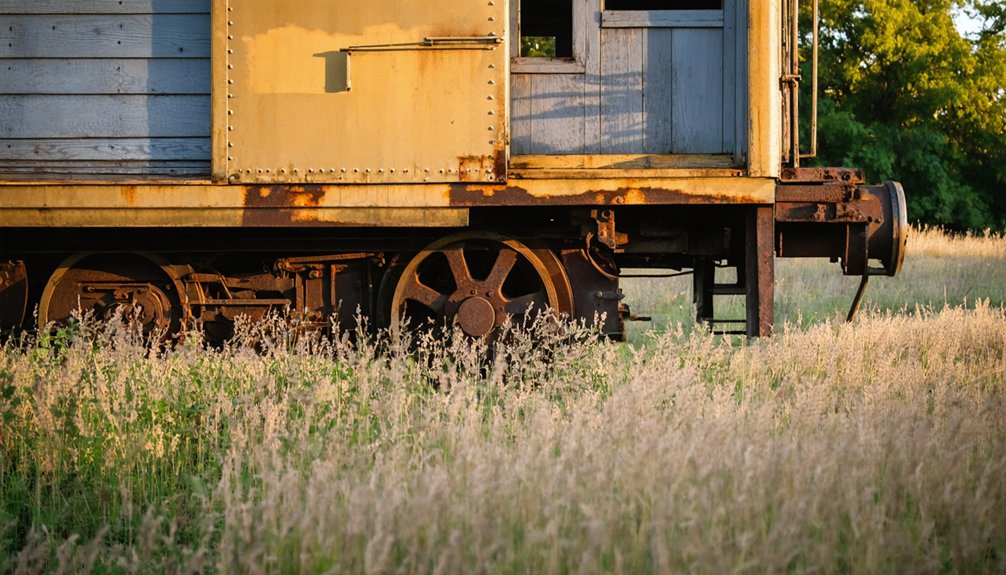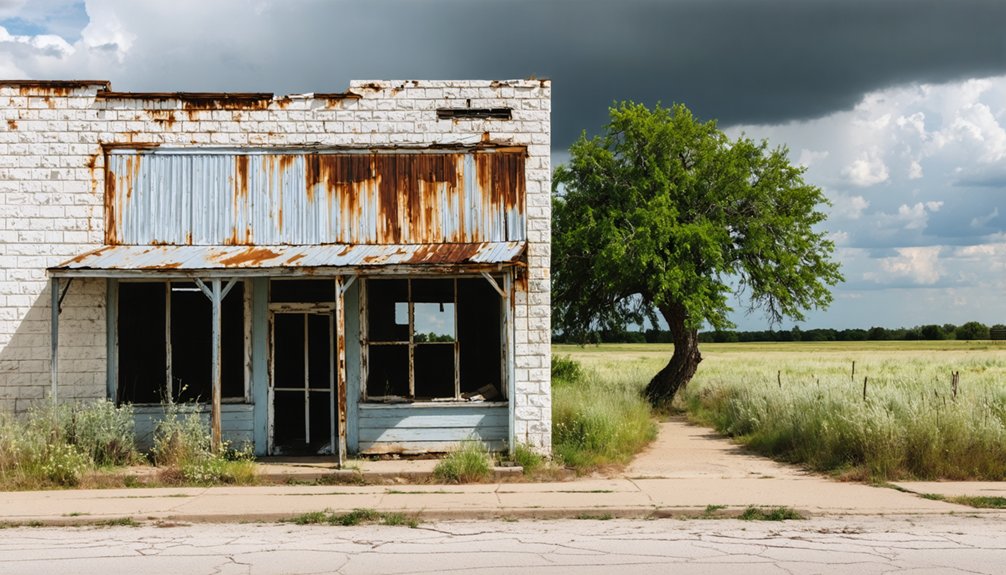You’ll find Rochelle, Texas nestled in McCulloch County, where a once-thriving railroad town of 700 residents now stands as a quiet reminder of Texas’s rail transport era. After the Fort Worth and Rio Grande Railway arrived in 1902, this small settlement transformed into a bustling trade center with stores, cotton gins, and a historic depot. When the last Gulf, Colorado and Santa Fe train passed through in 1959, Rochelle’s population dwindled to 100. The town’s preserved 1912 depot holds countless stories of its railroad glory days.
Key Takeaways
- Rochelle, Texas transformed from a thriving railroad town of 700 residents in 1914 to a ghost town after rail service ended in 1959.
- The town’s decline began when the Gulf, Colorado and Santa Fe Railway discontinued service, causing population to drop to about 100 residents.
- Once-bustling businesses, including three stores, two cotton gins, a hotel, and bank, largely disappeared after the railroad’s departure.
- The historic Rochelle depot, built in 1912, remains as a preserved landmark marked by historical marker #4315.
- The community adapted to decline by converting the depot into a Memorial Community Center in 1956, maintaining local heritage.
The French Connection: Origins of a Texas Town
Although Rochelle’s name suggests French origins, the town’s connection to French history runs deeper through Texas’s complex colonial past.
You can trace this heritage back to 1684, when French exploration of Texas began under René-Robert Cavelier de La Salle. His expedition, authorized by King Louis XIV, mistakenly landed at Matagorda Bay, establishing Fort Saint-Louis as France’s first settlement in Texas. After landing, initial farming efforts proved futile, forcing the settlers to hunt bison for survival.
While the fort’s eventual collapse marked a tragic end to France’s direct presence, it sparked an intense colonial rivalry that shaped Texas’s future. The fort’s demise came after most colonists perished in a devastating Karankawa raid in late 1688, with only four children surviving as adoptees of the tribe.
Spain, alarmed by French incursion into their claimed territory, responded by establishing missions and presidios throughout Texas. This French-Spanish competition for control would forever alter the region’s cultural landscape, leaving lasting influences that echo in place names like Rochelle.
Railroad Glory Days and Economic Boom
When the Fort Worth and Rio Grande Railway constructed its line through Rochelle in 1902, the sleepy settlement of 30 residents transformed into a bustling trade center. The railroad expansion brought unprecedented economic development to this Texas Hill Country community, connecting local farmers and ranchers to broader markets. Similar to how rail service from 1903 expanded through Brownwood to Brady, Rochelle experienced significant growth during this period.
You’ll find that Rochelle’s depot became the heart of commerce and social activity, especially after its reconstruction following a 1912 fire. By 1914, the town reached its peak of 700 residents with various businesses flourishing.
- Santa Fe system integration enhanced regional connectivity
- Agricultural shipping capabilities attracted new settlers and businesses
- Depot served as a crucial logistics hub for surrounding rural populations
- Local industries emerged to support railroad operations
- Hotels and retail establishments catered to increasing rail traffic
The railway’s arrival marked Rochelle’s golden age, establishing it as a significant trade hub while fundamentally reshaping the town’s economic landscape and cultural identity.
Life in Early 20th Century Rochelle
Following the arrival of the railroad, Rochelle blossomed from a tiny settlement of 30 residents into a vibrant rural community of 700 by 1914. You’d have found a bustling town with three stores, two cotton gins, a hotel, and a bank serving the needs of local farmers and ranchers.
Like many towns named Rochelle Park, this Texas community maintained its own unique identity while sharing similar rural characteristics. Life centered around the depot, schools, and churches, where you’d experience the strong community cohesion typical of rural Texas towns.
The Fort Worth and Rio Grande railroad line proved essential to the area’s agricultural development and early growth. The town’s educational trends mirrored those across Texas, as smaller one-room schoolhouses merged with Rochelle High School by the 1930s. Places like Placid, Claxton, and Round Mountain consolidated their students into one central campus.
Through it all, traditional rural values prevailed, with residents maintaining close-knit relationships and simple lifestyles that defined early 20th-century small-town Texas.
The Historic Depot’s Many Lives
The Rochelle depot stands as a symbol of the town’s enduring spirit, evolving from a bustling railroad hub to today’s cherished community center.
You’ll find this historic structure at its 1956 depot relocation site, where it continues to serve as the Memorial Community Center.
While the original depot burned, its 1912 replacement witnessed the flow of agricultural goods and passengers during Rochelle’s railroad heyday. J.F. Crew of Ohio established the settlement and was instrumental in bringing the railroad through town. Today, the area sees 80 to 90 trains passing through daily, carrying millions of tons of merchandise across the nation.
- First depot’s destruction by fire led to the 1912 frame structure construction
- Served as an essential transportation link between Brownwood and Brady
- Became part of the larger Santa Fe railway system
- 1956 depot relocation preserved the building for community use
- Now marked by historical marker #4315, commemorating its significance in local history
When the Trains Stopped Running
If you’d visited Rochelle in 1959, you’d have witnessed the last Gulf, Colorado and Santa Fe train roll through town, marking the end of an era that had sustained the community since 1912.
The railroad’s departure created an economic impact zone that rippled through local businesses, causing many to close their doors as commercial agriculture declined and transportation options dwindled. Texas railroads were vital to communities, reducing what was once a day-and-a-half stagecoach journey to just 1 hour and 40 minutes by rail.
Life after rail service proved challenging for the remaining residents, as Rochelle’s population plummeted from 700 to roughly 100 by the early 1960s, transforming this once-bustling railway town into a quiet ghost town.
Economic Impact Zone
Once rail service ceased in Rochelle, the town’s economic energy crumbled as its essential transportation artery shut down, triggering a cascade of business closures and job losses.
You’d have witnessed the rapid economic isolation as farmers lost their primary shipping method, forcing them to seek costly transportation alternatives. Similar to how the notorious Jericho Gap mudslides devastated travel and commerce, Rochelle’s transportation troubles proved catastrophic for local business.
Without the railroad’s lifeline, property values plummeted and tax revenues dried up, leaving the town struggling to maintain basic infrastructure and services.
- Local agriculture businesses faced mounting distribution costs and limited market access
- Freight handlers, suppliers, and maintenance shops closed or relocated
- Population declined sharply as railway-related jobs disappeared
- Property values and municipal revenues dropped considerably
- Hotels, restaurants, and other traveler-dependent businesses shuttered
Life After Rail Service
Following the economic collapse, daily life in Rochelle underwent profound changes as rail service ground to a halt by mid-century.
You’d find fewer residents each year, as the population dwindled from its 1914 peak of 700 when rail-dependent families moved away seeking work elsewhere. Despite the social isolation, community resilience emerged through creative repurposing of railroad structures – most significantly the 1912 depot, which became the Memorial Community Center in 1956.
The town’s younger generations often left, leaving an aging population to adapt to limited services and transportation options.
While some residents turned to small-scale farming and ranching for subsistence, the lack of efficient shipping methods made large-scale agriculture impractical.
The once-bustling rail hub became a quiet reminder of Texas’ railway era.
A Community’s Slow Fade
While Rochelle started modestly with just 30 residents in 1879, the arrival of two major railroads in the early 1900s transformed it into a bustling community of 700 by 1914.
You’ll find that despite economic challenges, the town’s community resilience kept the population above 500 through the 1950s.
Yet the 1959 abandonment of the Gulf, Colorado and Santa Fe railway struck a devastating blow, triggering an exodus that left just 100 residents by the early 1960s.
- The post office, established in 1879, remained a symbol of historical memory
- Local businesses, including stores, a hotel, and a bank, gradually shuttered
- Population never recovered to its pre-1959 levels
- Physical infrastructure deteriorated over subsequent decades
- Remnants like the old gas station still stand as silent witnesses to past prosperity
Preserving Rochelle’s Railroad Legacy

The historical Rochelle Depot stands as a tribute to the town’s rich railroad heritage, even as many other structures have faded into memory. Built in 1912, this representation of early railroad architecture has served the community in various ways, first as a crucial transportation hub and later as a community center since 1956.
You’ll find the depot’s significance highlighted by a Texas Historical Commission marker, awarded in 1982. While other Hill Country towns have preserved their railroad structures as museums, Rochelle’s unique approach keeps the depot actively serving its residents.
Local historical societies maintain the building and its interpretive markers, ensuring you can still experience the authentic character of this early 1900s structure. The depot continues to anchor heritage preservation efforts, connecting modern visitors to Rochelle’s defining railroad era.
Frequently Asked Questions
What Happened to the Original La Rochelle Settler Who Named the Town?
You won’t find records of what happened to the La Rochelle settler’s legacy – their identity and fate remain unknown despite their historical significance in naming the town in 1879.
Are There Any Remaining Businesses Still Operating in Rochelle Today?
You’ll find very limited current businesses in Rochelle today, with no confirmed local attractions or commercial establishments operating. Population growth hints at possible activity, but there’s no verified business presence.
What Was the Town’s Peak Population Before Becoming a Ghost Town?
You’ll find that Rochelle’s peak population reached 700 residents in 1914, when rail service was booming. Despite maintaining over 500 people through the 1950s, significant population decline followed the railway’s abandonment.
Did Any Famous Historical Figures Ever Visit or Live in Rochelle?
You won’t find any famous visitors or residents in Rochelle’s historical records. The town’s historical significance stems from its local settlers and community development rather than connections to notable personalities.
How Many Original Buildings From Rochelle’s Heyday Are Still Standing?
Ever wonder what remains of a once-bustling town? You’ll find fewer than ten original structures still standing, including the historic architecture of Rochelle School, some railroad homes, and scattered town preservation efforts.
References
- https://theforgottensouth.com/cheapside-texas-ghost-town-history/
- https://www.youtube.com/watch?v=2S7ugImqabY
- https://www.ghosttowns.com/states/tx/rochelle.html
- https://www.texasescapes.com/TexasHillCountryTowns/Rochelle-Texas.htm
- https://www.tshaonline.org/handbook/entries/rochelle-tx
- https://kids.kiddle.co/French_colonization_of_Texas
- https://texashighways.com/culture/history/the-tragic-tale-of-a-17th-century-french-colonys-collapse/
- https://64parishes.org/entry/french-colonial-louisiana
- https://en.wikipedia.org/wiki/Fort_Saint-Louis_(Texas)
- https://en.wikipedia.org/wiki/French_colonization_of_Texas



